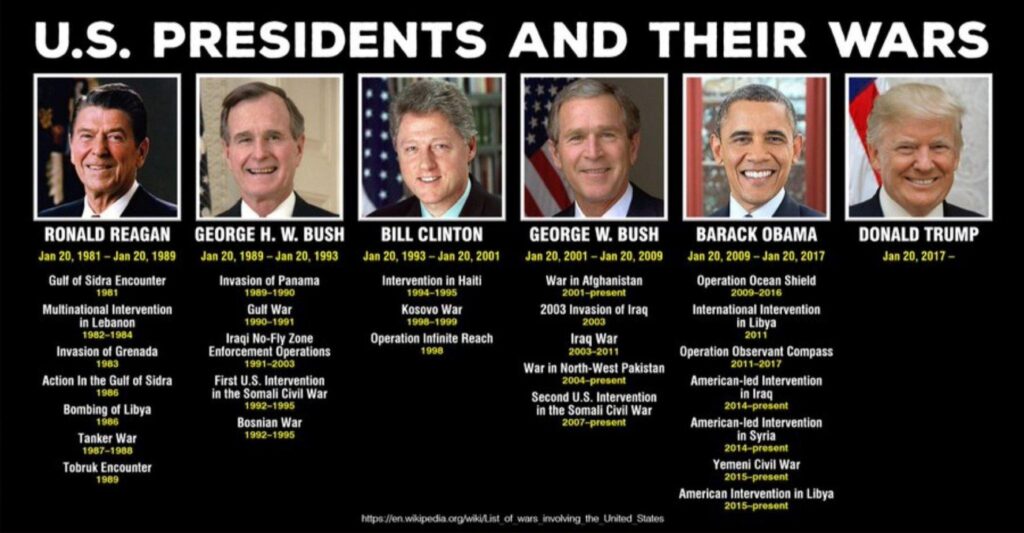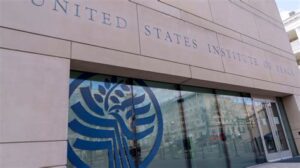American Wars by President Since World War Two

(The History Guy) Since World War Two, the United States has had 15 presidents. They all have dealt with an America at war, dealing with varying degrees of conflict. Most of them, such as President Trump, who took office in January of 2017, or President Biden, who took office in January of 2021, inherited wars begun or left over from their predecessors. Here is a listing of wars and conflicts under each president, beginning with the administration of Franklin Roosevelt in 1933 through the current administration of Joe Biden. As events warrant, new wars and conflicts will be added.
See also: Military History of the United States Timeline and The Wars of President Joe Biden
Wars of Franklin D. Roosevelt (1933-1945)
Inherited:
U.S. Occupation of Haiti, which Roosevelt ended in 1933
Initiated:
U.S. involvement in World War Two
Wars of Harry S Truman (1945-1953)Inherited:
World War Two. Truman made the decision to use two atomic bombs on Japan
Initiated/Engaged:
U.S. involvement in the Cold War against the Soviet Union and associated communist states and organizations
U.S. involvement in the Korean War
Cold War Crisis/Incidents:
Soviet Occupation of Northern Iran
Greek Civil War (U.S. supplied aid and military advisors to aid Greek government against communist rebels)
Berlin Crisis of 1948 and Berlin Airlift
Communist victory in Chinese Civil War. The U.S. supported the losing Nationalist Chinese side that then moved to the island of Formosa (now Taiwan), when they lost the war to the Communists.
Wars of Dwight Eisenhower (1953-1961)
Inherited:
Cold War
U.S. involvement in the Korean War
Initiated/Engaged:
Covert U.S. action in Guatemala and Iran
U.S. military intervention in Lebanon in 1958
Military Intervention in Vietnam (advisors sent in 1955. The U.S had 900 U.S. troops in Vietnam by the end of 1960)
Cold War Crisis/Incidents:
Taiwan Straits Crisis of 1954
Hungarian Revolution (Hungarians unsuccessfully rebelled against Soviets in 1956)
Fidel Castro’s victory in Cuban Revolution and his alliance with the Soviets. U.S. begins covert operations against Cuba, including planning for invasion by Cuban exiles.
U2 Spy Plane Shootdownand Crisis (1960)
Wars of John F. Kennedy (1961-1963)
Inherited:
Cold War
Covert Operations against Castro’s Cuba
U.S. involvement in the Vietnam War
Initiated/Engaged:
Increase of American involvement in Vietnam and Laos. By the time of Kennedy’s death in 1963, nearly 16,000 U.S. troops were in Vietnam.
Cold War Crisis/Incidents:
Berlin Wall Crisis of 1961
Bay of Pigs Invasion of Cuba by Cuban Exiles with U.S. aid in 1961 (planning had begun under the Eisenhower Admninistration)
Cuban Missile Crisis of 1962-Nearly led to war with Soviet Union
Wars of Lyndon B. Johnson (1963-1969)
Inherited:
Cold War
U.S. involvement in the Vietnam War. By the time Johson left office in January, 1969, over 500,000 U.S. troops were in Vietnam.
Initiated/Engaged:
U.S. Invasion/Intervention in the Dominican Republic in 1965
Cold War Crisis/Incidents:
Korean DMZ Conflict. Low-level combat along the Demilitarized Zone separating North and South Korea. This conflict lasted from 1966 to December of 1969. The U.S. suffered 43 dead and 111 wounded.
USS Pueblo Crisis of 1968 North Korea attacked and captured the U.S. Naval ship the Pueblo off the Korean coast.
Six-Day Arab-Israeli War of 1967. The U.S. supported Israel, while the Soviets supported Egypt, Syria, and Iraq
Wars of Richard M. Nixon (1969-1974)
Inherited:
Cold War
U.S. involvement in the Vietnam War. During the Johnson Administration, the war escalated to the point that in 1968, more than 500,000 U.S. troops were serving in Vietnam. Nison also sent troops to fight North Vietnamese forces in Cambodia and Laos as part of the Vietnam War.
Cold War Crisis/Incidents:
American North Korean Shootdown U.S. Navy EC-121 reconnaissance plane in 1969. The North Korean attack resulted in 31 U.S. servicemembers killed.
1973 Arab-Israeli War. Soviet-supported Arab states attacked Israel. The U.S. supported Israel. Intense U.S. and Soviet support of their allies nearly led to war.
Wars of Gerald R. Ford (1974-1977)
Inherited:
Cold War
U.S. involvement in the Vietnam War
Initiated/Engaged:
Final combat of the Indochina/Vietnam War in May of 1975, with the attempted rescue of the SS. Mayaguez from Cambodian communist rebels.
Cold War Crisis/Incidents:
Soviet and Cuban interventions in Africa.
1976 Axe Murder at Panmunjom. North Korean troops kill an American soldier at the truce village of Panmunjom, Korea.
Wars of Jimmy Carter (1977-1981)
Inherited:
Cold War
Initiated/Engaged:
Cold War Crisis/Incidents: Soviet and Cuban interventions in Africa
Soviet Invasion of Afghanistan. After the Soviet invasion of Afghanista, Carter initiated U.S. assistance to the Afghan resistance.
Wars of Ronald Reagan (1981-1989)
Inherited:
Cold War
Ongoing hostility with Iran
Initiated/Engaged:
U.S. Intervention in Lebanon
Covert War on Nicaragua (Contra War)-part of Cold War
Salvadoran Civil War-U.S. provided military assistance and advisors to aid the government of El Salvador against communist rebels, who were supported by Cuba and Nicaragua.
U.S. Invasion of Grenada- part of Cold War. U.S. forces engaged in combat with Cuban troops for the first time in the Cold War
U.S. Conflict with Libya
U.S. Involvement in Iran-Iraq War (Tanker War and Iran-Contra Arms Deals)
Cold War Crisis/Incidents:
Soviet and Cuban interventions in Africa. The U.S. provided both overt and covert assistance to nations and armed groups in Africa opposing Soviet and Cuban interventions in Angola and Ethiopia.
Soviet Occupation of Afghanistan (U.S. actively aids Afghan resistance against Soviets)
Wars of George H.W. Bush (1989-1993)
Inherited:
Cold War-With the dissolution of the Soviet Union, the Cold War ended in 1991
Ongoing hostility with Iran
Initiated/Engaged:
U.S Invasion of Panama in 1989
Persian Gulf War to liberate Kuwait against Iraq in 1990-1991
No-Fly Zone War in Iraq (U.S. and Britain enforced no-fly zones in northern and southern Iraq, while also initiated a virtual military occupation of the Kurdish areas of northern Iraq
U.S. Intervention in Somalia
Wars of Bill Clinton (1993-2001)
Inherited:
Ongoing hostility with Iran
U.S. Intervention in Somalia
Ongoing conflict with Iraq (No-Fly Zone War)
Initiated/Engaged:
U.S. Invasion of Haiti in 1991-Operation Uphold Democracy
Bosnian War (1992-1995)-The U.S. participated, along with NATO, in a war against Bosnian Serbs and Serbia in Bosnia.
Kosovo War of 1999- The U.S. participated, along with NATO, in a war against Serbia in order to facilitate the independence of Kosovo.
1998 Bombings of U.S. Embassies in Kenya and Tanzania by al-Qaida terrorists.
U.S. Retaliation against al-Qaida in Sudan and Afghanistan -These incidents are often referred to as the actual start of the U.S. war with al-Qaida and Islamic Jihadist groups. This retaliation was called Operation Infinite Reach.
Wars of George W. Bush (2001-2009)
Inherited:
Ongoing hostility with Iran
No-Fly Zone War against Iraq
Conflict with al-Qaida
Initiated/Engaged:
Hainan Island Incident (2001)–A U.S. Navy EP-3 reconnaissance aircraft operating above the waters of the South China Sea was struck by a Chinese Air Force interceptor jet.
September 11, 2001 Terrorist Attacks
War in Afghanistan-The U.S invaded Afghanistan to fight al-Qaida and the Taliban
Invasion and Occupation of Iraq
Wars of Barack Obama (2009-2017)
Inherited:
Ongoing hostility with Iran
War in Afghanistan
War in Iraq-The U.S. officially withdrew from Iraq in December of 2011.
Conflict with al-Qaida-includes Drone War against al-Qaida and other Jihadist groups in Pakistan, Yemen, Libya, and elsewhere.
Initiated/Engaged:
Libyan War of 2011
War with ISIS-The U.S. military returned to Iraq in 2014 to fight against the Islamic State (ISIS or ISIL). This war also takes place in Syria, Libya, Yemen, and other nations.
U.S. aid to France in Mali War (2014)-U.S. provides air support, logistics, and other aid as France intervenes to stop Jihadist offensive in Mali
U.S. intervention in Joseph Kony conflict-U.S. troops aid Ugandan and other African militaries hunt down insurgent and terrorist Joseph Kony.
U.S. Intervention in Libyan Civil War (2014-Present)-U.S. involvement is primarily directed against Jihadist elements in Libya.
U.S. Intervention in Yemen Civil War -U.S. involvement is primarily directed against Jihadist elements in Yemen.
U.S. Intervention in Somali Civil War U.S. involvement is primarily directed against Jihadist elements in Somalia.
Wars of Donald J. Trump (2017-2021)
Inherited:
Ongoing hostility with Iran. This ongoing conflict escalated sharply in December 2019 and January of 2020, with Iranian-proxy forces (Iraqi Shiite militias) attacking U.S. bases in Iraq, killing American personnel. U.S. responded by killing a Shiite militia leader and a major figure in the Iranian Revolutionary Guards. Iran responded with missile attacks on two U.S. bases in Iraq, injuring over a hundred American troops.
War in Afghanistan
Wars Against ISIS, al-Qaida and other Islamic Jihadist groups in Iraq, Syria, Pakistan, Yemen, Libya, Somalia, northern Africa and elsewhere.
American Missile Strike on Syria (April 6, 2017)-In response to the Assad regime’s apparant use of chemical weapons on a civilian target, the April 4 chemical attack in Khan Sheikhoun, United States President Donald Trump ordered a retaliatory strike against the Syrian air base at Al Shayrat. See also: American-Syrian Wars.
Wars of Joseph R. Biden (2021-Present)
Inherited:
Ongoing hostility with Iran.
In response to attacks (rockets and drones, primarily) the U.S. has launched retailatory strikes against Iran-backed (i.e. proxies for Iran) on these dates:
February 25, 2021: President Biden ordered retaliatory airstrikes on Iraqi Shiite militia targets located in eastern Syria. This was in response to an attack on February of 2021, when Iranian proxies (again, Iraqi Shiite militias) launched three attacks on American targets inside Iraq. One U.S.-mployed contractor was killed and U.S. troops were injured.
June 27, 2021: President Biden ordered retaliatory airstrikes on Iraqi Shiite militia targets located along the Iraq/Syria border. This was in response to drone attacks on bases in northern Iraq that housed U.S. forces. The two Shiite groups hit were the Kata’ib Hezbollah and Kata’ib Sayyid al-Shuhada militia groups. Iraqi media reported that four militia members died in the attack.
June 28, 2021: In response to the previous day’s airstrikes, militia forces respond with rocket attacks on U.S. troops on the ground in Syria near al-Omar. The U.S. reported no American casualties, and responded with artillery fire at the “rocket-launching platforms.”
War in Afghanistan (President Biden withdrew American forces on August 30, 2021).
Wars Against ISIS, al-Qaida and other Islamic Jihadist groups in Iraq, Syria, Pakistan, Yemen, Libya, Somalia, northern Africa and elsewhere. This ongoing conflict with the terrorist group includes a successful special forces raid on the leader of ISIS, conducted in February of 2022. American forces attacked the ISIS -held building in the Idlib area of Syria. The ISIS leader, Abu Ibrahim al-Hashimi al-Qurashi, died in the raid on February 3, 2022. Rather than be captured, al-Qurashi blew himself, and his family up. The U.S. forces reported no American casualties.
In addition to the ongoing war with ISIS, U.S. forces have also sporadically been drawn into conflict with the Houthi faction in the Yemeni Civil War. The U.S. under Presidents Obama and Trump supported the Saudi-led coalition fighting the Iran-backed Houthis, though President Biden rescinded that support in 2021. However, in February, 2022, Houthi and allied Shiite Iraqi militias (the True Promise Brigades) conducted missile and drone attacks on targets in the United Arab Emirates (the UAE). The UAE is a member of the anti-Houthi coalition. American anti-missile defense units stationed in the UAE (where the U.S. has military bases), launched Patriot missiles at the incoming missiles. This was the first combat use by the United States of Patriot Missiles since the 1991 Gulf War. Source: Military Times
With the Russian invasion of Ukraine in 2022, the United States has increased support for Ukraine, providing weapons, training, money, and economic and political support. It is not out of bounds to say that under President Biden, a new Cold War has developed with Russia. Given Iranian, North Korean, and Chinese support for Russia, the prospects of a new, global cold war are increasing.
Israel-Hamas War:
In October, 2023, the Palestinian terrorist group Hamas attacked Israel in a surprise offensive. President Biden declared American support for Israel in this new war, sending a U.S. Navy carrier group to nearby waters, while promising delivery of weapons and ammunition to Israel. Several American citizens were killed in the Hamas attack, which could also further U.S. involvement.
Since the start of the Israel-Hamas War, American involvment has increased. The U.S. is supplying massive amounts of munitions and equipment to Israel. Also, President Biden ordered a second Carrier Task Force to the region. As expected, Iranian-allied (and most likely Iranian-controlled) Shiite militias in Iraq and Syria have targeted American forces in the region. Also, a U.S. Navy Destroyer interecpted mulitple missiles and drones launched by Yemen’s Houthi regime that were aimed at Israel.
-Oct. 18, 2023-U.S. troops at al-Tanf base in Syria targeted by drones launched by Iran-allied Shiite militia. One drone was shot down, the other hit the base, causing minor injuries.
-Another drone targeted the U.S. base at al-Asad in western Iraq. The drone was shot down. Rockets hit the Baghdad airport, where U.S. and coalition forces are based. The Islamic Resistance in Iraq, an umbrella group of Iranian-backed militias, claimed responsibility for the attacks.
-Oct. 19, 2023–USS Carney, in the northern Red Sea, shot down four cruise missiles and 15 drones over a period of nine hours launched by Houthi forces in Yemen. The attack appeared headed toward Israel.
U.S. retaliatory strikes on militia targets in Syria and Iraq have continued, but attacks on American and Coalition forces continued.
By January, 2024, American forces in Iraq and Syria had incurred dozens of casualties in over 80 attacks by Iran-backed militia forces. In addition, on January 11, 2024, U.S. and UK forces retaliated against Houthi targets in Yemen. Allied airstrikes continued, though Houthi attacks on ships continued.





